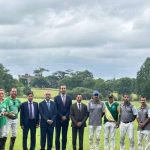Archaeologists from Bahrain and the United Kingdom have recently unearthed what is believed to be one of the oldest Christian buildings in the Arabian Gulf, shedding light on a thriving Christian community in the region. The Church of the East, also known as the Nestorian Church, was prominent in the area until the 7th century AD, coinciding with the spread of Islam in the region. Radiocarbon dating confirmed the building at the Samaheej archaeological site in Muharraq was inhabited from the mid-4th to the mid-8th centuries AD, before being abandoned.
The joint excavation project by the Bahrain Authority for Culture and Antiquities (BACA) and a British team led by Professor Timothy Insoll revealed significant findings in 2023. The excavations at the Samaheej cemetery led to the discovery of a large building believed to be the episcopal palace of the bishop of the diocese, including living quarters and workspaces. The discovery is particularly noteworthy given the building’s location in a modern, densely populated town, as previous Christian sites in the region were often found in remote areas.
The archaeological findings at the site include early Christian symbols such as crosses and wall paintings, indicating the Christian identity of the inhabitants. The discovery of various artifacts like glass drinking cups, agate gemstones, and Indian pottery suggest trade connections with India. Professor Insoll stressed the importance of preserving the site, which provides valuable insights into the daily lives and religious practices of the Christian community in that era.
Dr. Salman Al Mahari highlighted the significance of the excavation at the Samaheej archaeological site for Bahrain’s history. The discovery of the 1600-year-old building has shed light on the period of Christian presence in the region and provided researchers with valuable insights into Bahrain’s history. The well-preserved structure with its stone walls, plaster floors, and artifacts like spinning tools and copper coins offers a glimpse into the lifestyle of the building’s inhabitants.
The findings at the archaeological site indicate that the building’s residents enjoyed a good standard of living, consuming a variety of meats, fish, and crops. The presence of agate gemstones and Indian pottery suggests engagement in trade activities, while the discovery of currency from the Sassanid Empire and fabric-making tools provides further insights into the economy and industries of that era. The site has also revealed personal artifacts like a pearl shell with a drawn face, possibly depicting a man who lived in the building.
The recent excavation has brought to light the Nestorian Church’s presence in Bahrain, offering a glimpse into how people lived, worked, and worshipped in the ancient Christian community. The discovery of the building not only highlights the historical and archaeological significance of the site but also underscores the need for preservation and protection of this invaluable piece of Bahrain’s history. Research and analysis of the artifacts found at the site will continue to provide researchers with a deeper understanding of the region’s rich heritage and cultural legacy.











